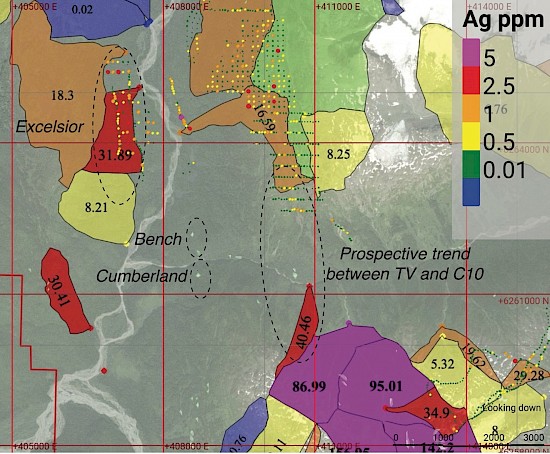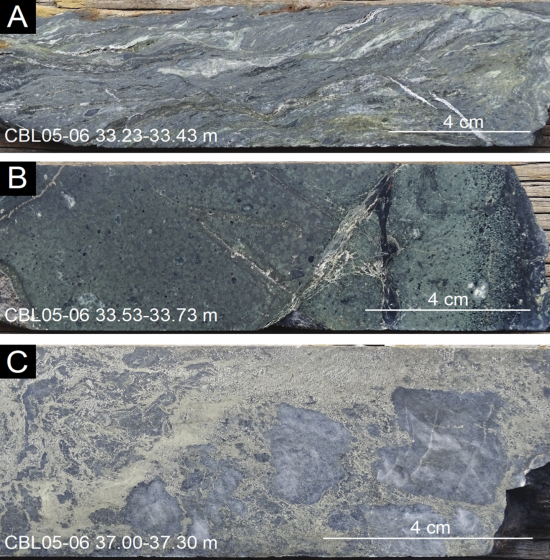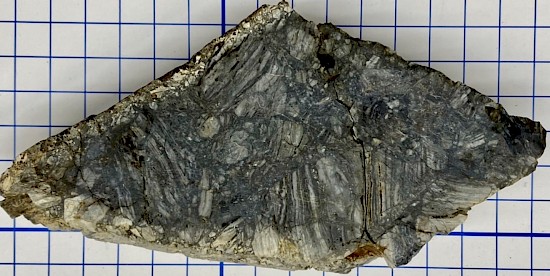Cumberland, Excelsior, and Virginia Lakes (Figure 1) are VMS showings hosted within upper Hazelton Group rhyolite and basalt, and represent a southern extension of the stratigraphy that hosts the world-class Eskay Creek mine. The area hosts several very strong soil Ag and Au BLEG anomalies (Figure 1) that define the east and west limbs of the southern portion of the Eskay anticline.

Figure 1: Gold BLEG map of the Excelsior region (color-coded polygons with results shown in ppb), also showing Ag results for soil samples (dots) collected during the 2021 and 2022 exploration programs. The Excelsior prospect is associated with a trend of strong BLEG anomalies and elevated Ag concentrations in soil samples. BLEG results suggest that the TV trend of VMS mineralization may continue southwards towards C10. Drilling and field exploration during 2021 and 2022 indicate that the Betty Creek Formation stratigraphy that hosts C10 and TV extends between the two showings.
Cumberland
Cumberland hosts VMS Au mineralization (Figure 2) at an equivalent stratigraphic horizon to the Contact Mudstone at Eskay Creek. The Eskay rhyolite-Willow Ridge contact was intercepted by drill hole CBL05-06. The interval 28.66-33.53 m is a mudstone with sparse flattened black pebbles (<5 mm), and a well-developed S-C fabric (Figure 3A). Sulfide minerals and calcite are concentrated on the S plane of the S-C fabric. Historic assays from this mudstone interval range from 1.00-1.97 g/t Au. Dark grey-green basalt with sparse calcite amygdales was intercepted from 33.53-35.55 m (Figure 3B). Rhyolite breccia replaced with semi-massive replacement-style sulfide minerals occurs from 35.55-43.07 m (Figure 3C). Historic assays from the mineralized rhyolite breccia range from 0.20-7.83 g/t Au. The stratigraphic position of the mudstone and rhyolite breccia along the west limb of the Eskay anticline is consistent with a VMS hydrothermal system at the Contact Mudstone horizon.
Examination of historic grab samples of drill core from the non-mineralized Bench prospect along strike 1 km to the north of Cumberland intercepted a sequence of basalt underlain by mudstone and rhyolite. The sequence of lithologies at Bench (Figure 1) and its location along strike from Cumberland indicates that the Contact Mudstone horizon is at or near the surface, having emerged from under the Bowser Lake Group hanging wall of the Coulter Creek Thrust Fault.

Figure 2: Cross-section view of Cumberland looking east showing assay results in Au equivalent (Au+Ag/78). Many of the mineralized drill holes terminate in Au mineralization. This, plus the possibility for stacked VMS mineralization not tested by the shallow drilling done at Cumberland so far, raises the possibility for additional discoveries at Cumberland.

Figure 3: Mineralized drill core from drill hole CBL05-06 showing sulfide mineralization associated with the Willow Ridge basalt-Eskay rhyolite contact. Image A shows an intensely sheared carbonaceous mudstone with white bands of barite, a common alteration mineral associated with seafloor-hosted VMS mineralization. Image B shows hydrothermally altered Willow Ridge basalt less than 4 meters above the strongly replacement-style mineralization of Eskay rhyolite shown in image C.
Excelsior
The Excelsior target is associated with a Au BLEG anomaly and Ag soil anomalies (Figure 1). Field investigations in 2022 identified east-dipping beds of Eskay rhyolite (Figure 4), the same host rock for the world-class Eskay Creek Au-Ag VMS deposit. Previous drilling in the area was drilled parallel to bedding and away from the BLEG and soil anomalies, consequently the Excelsior target has not been adequately tested by drilling. This area is highly prospective for upper Hazelton Group-hosted VMS mineralization.

Figure 4: A sample of flow-banded Eskay rhyolite breccia from Excelsior. The association of Eskay rhyolite with Au BLEG and Ag soil anomalies suggests that Upper Hazelton Group VMS mineralization may occur at Excelsior.
Virginia Lakes
Investigations of magnetic anomalies during the late 1980’s and early 1990’s led to rock chip sampling and limited drilling of the Virginia Lakes target (Figure 5), immediately east of the Harrymel fault, and major strike-slip fault running north-south near the western boundary of Eskay’s Property. Drill hole R91-4 yielded gold grades up to 1.8 g/t surrounded by highly anomalous Au values occur from the collar down to 26.26 m. Core logs from the 1991 drill program conducted by Granges at Virginia Lakes indicate that sulfide mineralization is hosted by upper Hazelton Group rhyolite. A trend of Au- and Ag-bearing rock chip samples extending northwards from the R91 drill holes is coincident with a pronounced magnetic susceptibility anomaly (Figure 6), and includes sample 28756 that yielded 33.02 g/t Au and 50,071 g/t Au. The upper Hazelton Group stratigraphy, Au and Ag anomalism, and pronounced magnetic anomalies make Virginia Lakes a compelling target for further boots on the ground exploration, to be followed by drilling if warranted.

Figure 5: Map view of the R-grid where rock chip sampling and drilling at Virginia Lakes was conducted in 1991. A cluster of auriferous rock chip samples is associated with a magnetic anomaly (top right). Drill results are shown as Au equivalent (Au+Ag/78), and yielded tens of meters of anomalous Au mineralization grading up to 1.824 g/t Au equivalent. The host rocks for this mineralization are reported as felsic breccia, and are likely to belong to the upper Hazelton Group. Field investigations planned for 2023 will return to this area for confirmation of the rock type, and to define the larger trend of mineralization associated with magnetic anomalies.

Figure 6: Maps showing magnetic tilt derivative data (top) and the modeled 0.001 SI 3D magnetic susceptibility surface for the Virginia Lakes area. The trend of Au- and Ag-bearing rock chip samples coincides with a pronounced magnetic anomaly. Of particular note is the pronounced magnetic susceptibility anomaly associated with rock chip sample 28756 that yielded 33.02 g/t Au and 50,071 g/t Ag (from Assessment Report 19,347).
